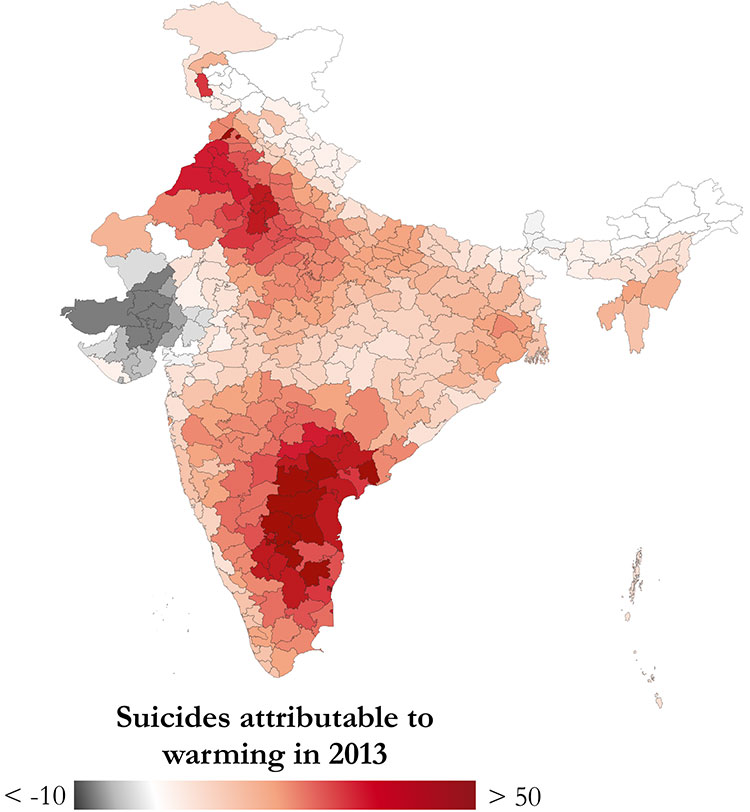August 2, 2017 – Those who study agriculture are more aware of climate change than most. They track and assess trends for incidents of extreme weather. They study rainfall patterns. They look at evapotranspiration rates (the rate that plants and soil give up moisture to the air). They look at temperature. But in India, they have another farming statistic, suicides per year. It seems odd and troubling that the country tracks the suicide rate among farmers. But this is not unique.
In a Huffington Post blog from July of 2014, Terezia Farkas writes “suicide rates in farmers are the highest of any occupation” describing it as an international crisis. But no country is as bad as India where farm suicides have become an epidemic. Here are some recent statistics:
- In Maharashtra state in the first four months of 2017, 852 farmers committed suicide. The reason is believed to be related to a prolonged drought.
- In 2015, the country reported 12,602 farmers committed suicide. Since 2014 suicide is illegal in India so this number is likely underreported data.
- Tamil-Nadu state, experiencing its worst drought in 140 years, has shipped the skulls and bones of farmers who have committed suicide and deposited them in a pile near India’s Parliament building in Delhi.
- Total farm suicides since 1995 exceed 300,000.
Indian farmer suicide rates have doubled since 1980, and based on a new research study published in the last month in the Proceedings of the National Academy of Sciences of the United States, climate change is contributing a 6.8% upward trend to this appalling statistic. In the study author, Tamma Carleton EPA STAR Fellow and Ph.D. student in Agricultural & Resource Economics at UC Berkeley, reviews 47 years of Indian suicide records, noting that India contributes 20% of global suicides annually. She further writes that the climate, “particularly temperature” plays a particular role in these somber statistics. For example:
- A temperature rise of 1 Celsius (1.8 Fahrenheit) during India’s growing season equates to 65 suicides.
- A temperature rise on one day of 5 Celsius (9 Fahrenheit) recently caused 335 farmers to kill themselves.
Among farmers, suicides almost always coincide with India’s growing season. She concludes that “warming over the last 30 years is responsible for 59,300 suicides” and attributes this level of self-harm to climate. She notes, “Without interventions that help families adapt to a warmer climate, it’s likely we will see a rising number of lives lost to suicide as climate change worsens in India.”

The narrative associated with suicide includes growing crop failures, and rising bank indebtedness, all tied to climate changes over the last four decades. And with more than 50% of India’s working population in “rain-dependent agriculture” sensitivity to climate change, and in particular fluctuations in the annual monsoon, longer periods of drought, and record breaking prolonged heat, something needs to be done to end the suicide epidemic.
Carleton is cautious in her use of the statistics stating that her estimates of “temperature-linked suicides” are lower than reality since deaths are generally underreported in India and because suicide is a criminal offense.
What can Indian farmers and the government do to mitigate this growing problem?
- Farmers need to change planting and field management practices to minimize evapotranspiration.
- Farmers need to develop surface water retention ponds and use these to provide local irrigation during dry periods.
- Farmers need to diversify what is planted including the planting of heat-tolerant trees to help reduce ground temperatures.
- Governments need to provide affordable credit and crop insurance to ensure farmers aren’t burdened with debts they cannot repay in the event of crop failures.
Without such policies and practices in place, the Indian farm population will continue this appalling level of self-harm.















